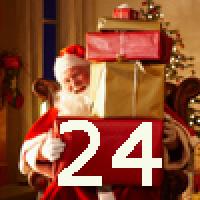
Plus Advent Calendar Door #24: Santa's knapsack problem

Santa's just putting his hat on and button up his jolly red coat when an exasperated elf runs up to him: "Santa! We've got a problem! There have been so many good children this year we can't put all the presents into your sleigh!"
The problem is that Santa's sleigh has a weight limit, and can only carry 2 tonnes of present. Each present has a different weight, and each present has a different star value too: a star for each good deed of the toy's recipient. Santa obviously wants to reward as many good deeds as possible, maximising the total star value of the presents in the sleigh. But he can't exceed the maximal weight or those presents are going nowhere! So which should he put in his sleigh?
The elves start out trying all different combinations of presents to find the best one. This would have been fine if there only were a few items, but they quickly realise it is totally impractical when you have millions of presents to deal with. If they carry on this way Christmas Eve will have long passed and no presents at all will be delivered!
Such a brute force solution is unacceptable, and not only to the elves and Santa. Mathematicians would also find this an unacceptable approach, and ask whether there is an algorithm – a recipe for finding a solution – which works for any number of items, and so that the time it takes to complete the algorithm grows with the number of items in a reasonable, non-explosive fashion.
Mathematicians have a clear definition of "reasonable and non- explosive" in this context: the time it takes to complete the algorithm should grow with the number N of items no faster than the polynomial N to the power of K, for some integer K, grows with N. That's still pretty rapid growth, especially if K is large, but at least it's not exponential.
So does such a polynomial time algorithm exist for our problem? The answer is that nobody knows - not yet - though most mathematicians believe that there isn't. In fact, if you can prove or disprove that a polynomial time algorithm exists you will have answered the question behind door #22 too, as they both can be turned into NP complete problems.
Optimisation problems such as this one, which is known as the knapsack problem, crop up in real life all the time. Thankfully Santa is well read in mathematical literature and knows an algorithm they can use that won't take too long and, while it not give the very best combination of starred pressies, it will get sufficiently close.
So rest assured, if you've been really, really good, your present is probably now packed on the sleigh, ready for the Santa's big delivery run. Merry Christmas!
You can find out more about NP complete problems on Plus.Back to the Plus Advent Calendar